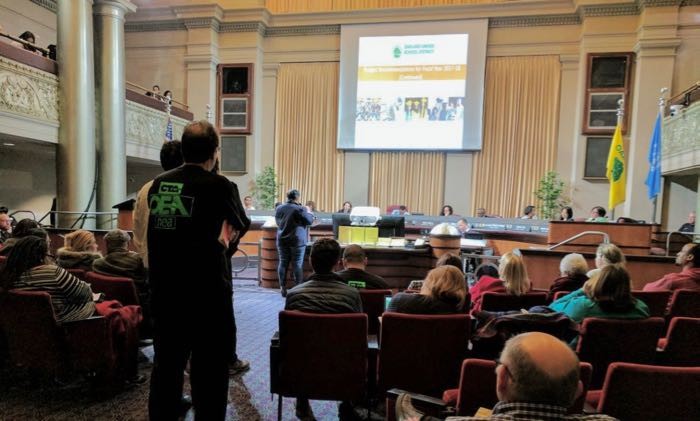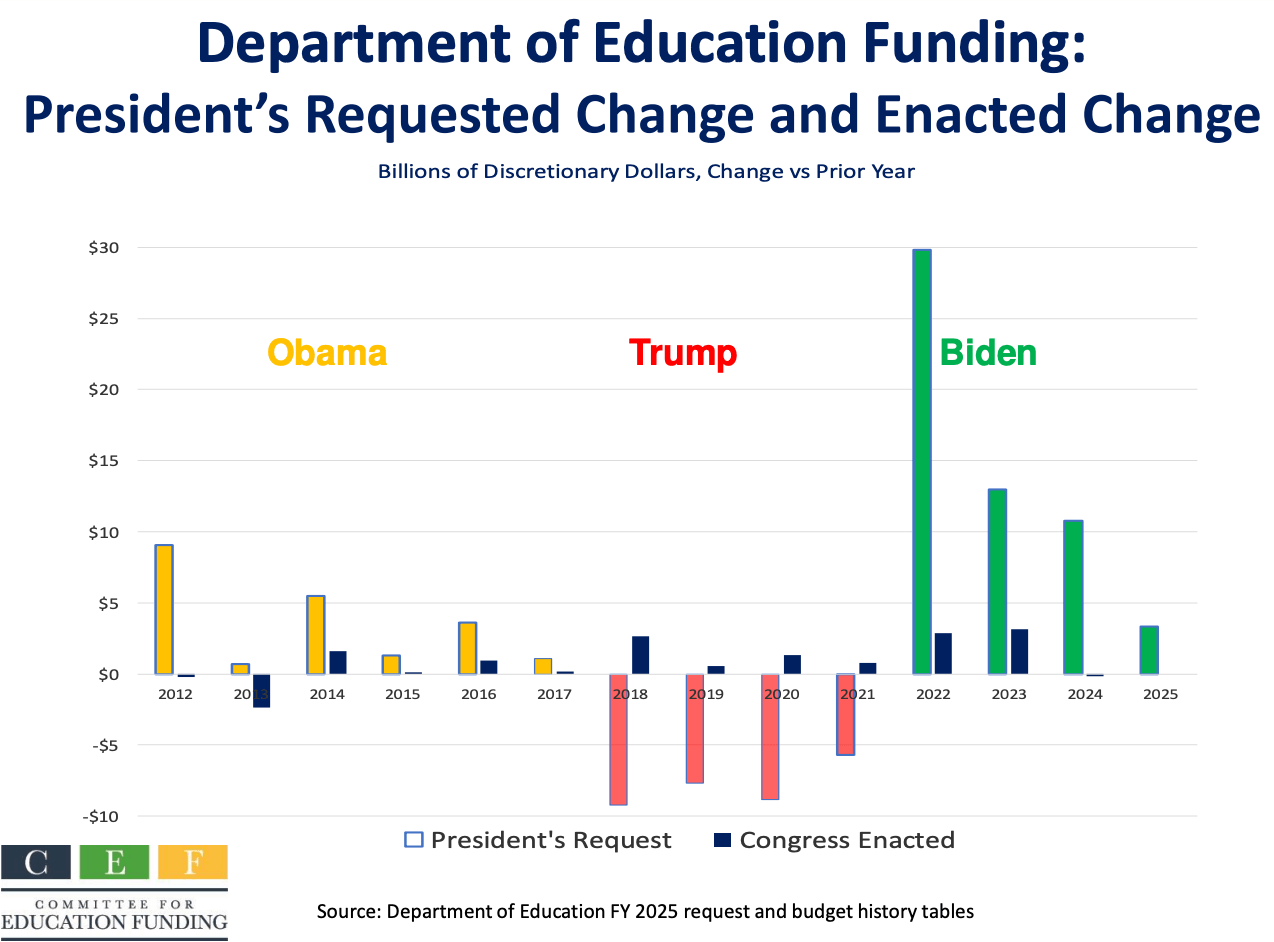Federal cuts ahead for education

California schools face serious financial and curriculum threats
A chainsaw of new presidential proclamations on education threatens to slash school systems already struggling to keep it together.
Among the challenges are threats to cut funding if schools fail to align with the Trump administration’s interpretation of diversity and inclusion policies. Teacher training grants have been cut based on shifting views about topics deemed too “woke.”
Meanwhile, the Institute of Education Sciences (IES) — a key source of research and data — is in the process of being dismantled.
This post unpacks these major changes and provides context. Where possible, we’ve included links to detail what has been cut. However, tracking these changes is increasingly difficult, as some web pages that describe federal education programs are disappearing.
The role of the federal government in education
Let’s back up a little. Public education is carried out locally, through school districts. Most laws about education are state laws, not federal laws. Federal programs play an equalizing role in education — they help to pay for school lunch and breakfast programs, for example. In disadvantaged communities, federal programs support teacher salaries for early education and special education. In California, about a tenth of the money for public schools comes from the federal budget. In Mississippi, federal funds play a larger role. In Connecticut, they play a smaller role.
The federal Department of Education (DOE) also plays an essential role in enforcing civil rights in education. Data assembled by the federal government helps overcome states' noisy, varying approaches to figure out what works. See organization chart and FY2025 budget (if available).
While federal money is a relatively small part of overall education funding in California, it is not small change. It's billions. The Education Law Center provides a breakdown.
Trump administration changes
The first weeks of the second Trump administration in 2025 saw significant efforts to implement campaign promises related to education. The table below summarizes the education-related priorities expressed in Project 2025 and the Trump campaign’s Agenda 47, along with actions taken so far.
|
2025 Presidential Education Transition Plans |
||
|---|---|---|
|
Actions as of Feb 2025 |
||
|
Eliminate the Department of Education: “Federal education policy should be limited and, ultimately, the federal Department of Education should be eliminated.” |
“Most of the activities of the federal government should be limited to statistics gathering.” Trump has vowed to get rid of the Department of Education by reducing programs managed by the Office of Elementary and Secondary Education and transferring some remaining programs to other federal agencies. |
Cuts to Education Department research |
|
Restore local and state government control |
Funding would be sent to local agencies as grants with no strings attached. e.g. Students with disabilities (IDEA) Title l |
|
|
Take money away from public schools to be used for private and religious schools “Ultimately, every parent should have the option to direct his or her child’s share of education funding through an education savings account (ESA), funded overwhelmingly by state and local taxpayers, which would empower parents to choose a set of education options that meet their child's unique needs.” |
Trump has expressed strong support for vouchers and school choice. Context: Read Ed100 blog post on school choice. |
President Trump issued an expansive executive order on “school choice” January 2025. |
|
End Title I federal funding for low income students within 10 years. |
Ed100 note: About 63 percent of traditional public schools and 62 percent of public charter schools are eligible for Title I funding. |
|
|
Ban Critical Race Theory and increase parent rights. “Enforcement of civil rights should be based on a proper understanding of those laws, rejecting gender ideology and critical race theory." Context: Ed100 explanation of Parent Rights |
President Trump promised to “turn the tide of left-wing indoctrination and once again respect the fundamental right of parents to control the education, healthcare, and moral formation of their children.” |
U.S. Department of Education Directs Schools to End Racial Preferences Feb. 2025 U.S. Department of Education Cuts Over $600 Million in Divisive Teacher Training Grants Feb. 2025 |
|
Strengthen protections for faith-based educational institutions and programs |
“Freedom to pray” in public schools. |
Diversity, Equity, and Inclusion (DEI)
War on "Woke"
The Trump administration issued a Dear Colleague letter in February 2025 to threaten school districts and colleges that they will lose federal funding if they don’t follow the administration’s interpretation of laws regarding race. The letter reads, in part:
“Educational institutions have toxically indoctrinated students with the false premise that the United States is built upon ‘systemic and structural racism’ and advanced discriminatory policies and practices. “
“Proponents of these discriminatory practices have attempted to further justify them—particularly during the last four years—under the banner of ‘diversity, equity, and inclusion’ (DEI), smuggling racial stereotypes and explicit race-consciousness into everyday training, programming, and discipline.”
A letter is NOT the law.
This letter expresses the Trump administration's interpretation of the law based on the Supreme Court’s 2023 decision in Students for Fair Admissions v. Harvard (SFFA), which held that the use of racial preferences in college admissions is unlawful.
The Trump administration argues that “The Supreme Court’s holding applies more broadly. At its core, the test is simple: If an educational institution treats a person of one race differently than it treats another person because of that person’s race, the educational institution violates the law.”
Many disagree with this expansive interpretation, which will face legal challenges. (See legal analysis.) Two Trump administration efforts related to DEI have already been halted by a district court.
Teacher training cuts
The U.S. Department of Education has revoked over $600 million in teacher training grants previously awarded to institutions and nonprofits using taxpayer funds to train educators and education agencies. The Trump administration justified the decision by labeling the programs as promoting “divisive ideologies,” including Critical Race Theory, Diversity, Equity, and Inclusion (DEI), social justice activism, “anti-racism,” and teachings on white privilege and white supremacy.
California voters long ago banned affirmative action by passing Proposition 209 in 1996:
“The State shall not discriminate against, or grant preferential treatment to, any individual or group on the basis of race, sex, color, ethnicity, or national origin in the operation of public employment, public education, or public contracting.”
Local schools will wrestle to determine whether curriculum and programs fall within the Trump interpretation. Are honor rolls by ethnicity acceptable? History lessons that emphasize multicultural issues? Clubs and extracurricular activities that support a group of students such as LGBTQ+ or African American students?
The Dear Colleague letter stated that districts had two weeks to comply, but significant questions remain—not just about what compliance entails, but also whether the Trump administration has the authority to withhold funds in the first place.
Cuts to education research
The Trump administration has announced cuts of nearly $1 billion in education contracts, effectively shutting down much of the Institute of Education Sciences, the main agency tasked with conducting research on education in America. According to the National Education Policy Center, cancellations affect data on higher education and K-12 education as well as data that informs funding of the Individuals With Disabilities Education Act (IDEA). The National Center for Education Statistics (NCES) has been the federal statistical agency responsible for collecting, analyzing, and reporting data on the condition of U.S. education since 1867. NEPC Fellow Bill Penuel of the University of Colorado Boulder wrote on LinkedIn:
“Canceling NCES contracts impacts our ability to understand the conditions and progress of schools toward meeting educational goals enshrined in laws like ESSA, IDEA, and the Equal Education Opportunity Act and mandated by court decisions like Lau v. Nichols”
NPR reports that the National Assessment of Educational Progress (NAEP) will not be cut… at least, not yet. Ed100 Lesson 1.1 explains the importance of this national assessment. Since 1969 it has served as a vital yardstick for determining which systems are working better than others and for which students.
Spending freeze?
A Trump-ordered federal spending freeze, which would affect many services and programs that support children and schools, has been stopped, for now. A federal court ruled that the administration lacks the constitutional authority to impound funds that have been allocated by Congress.
Matthew J. Vaeth, Acting Director of the federal Office of Management and Budget (OMB) explained the purpose of the freeze in a memorandum:
“The use of Federal resources to advance Marxist equity, transgenderism, and green new deal social engineering policies is a waste of taxpayer dollars that does not improve the day-to-day lives of those we serve.”
Writing for Education Week, Mark Lieberman reports that such a freeze could impact “plans to make school buildings more energy-efficient, initiatives to replace diesel buses with clean-energy alternatives, early childhood education providers, efforts to boost pedestrian safety near school campuses, services for helping high school students with disabilities transition to adulthood, and health supports for mental middle schoolers.”
Funding is protected by laws passed by Congress
Among the three branches of government, funding (the “purse”) is determined by Congress under Article I of the Constitution. Congress has created two major federal education funding sources for education: Title I for low income students and IDEA for special education.
In every year of his first administration, President Trump proposed cuts to public education. See details for each year: 2018, 2019, 2020, 2021. Every year, Congress disregarded these proposals.
In a speech on Jan 28, 2025, Senator Amy Klobuchar emphasized that the legislature is a co-equal branch of government, and questioned the validity of the order to withhold funds. “The founding fathers didn’t give that power to Matthew Vaeth,” she said. “They gave it to us.”
Historically, it has been common for presidents to propose big swings in federal education funding as part of their budget request to Congress. In practice, Congress has always shrugged off these proposals in the end, supporting public education in a fairly stable, reliable manner despite the political noise. (See blue bars in the chart below. Prior administrations at CEF.)
The risk to children and families is that this time could be different. As Congress allows political posturing to become chainsaw policy, kids and families will be hurt.
Tags on this post
Budgets Funding PoliticsAll Tags
A-G requirements Absences Accountability Accreditation Achievement gap Administrators After school Algebra API Arts Assessment At-risk students Attendance Beacon links Bilingual education Bonds Brain Brown Act Budgets Bullying Burbank Business Career Carol Dweck Categorical funds Catholic schools Certification CHAMP Change Character Education Chart Charter schools Civics Class size CMOs Collective bargaining College Common core Community schools Contest Continuous Improvement Cost of education Counselors Creativity Crossword CSBA CTA Dashboard Data Dialogue District boundaries Districts Diversity Drawing DREAM Act Dyslexia EACH Early childhood Economic growth EdPrezi EdSource EdTech Education foundations Effort Election English learners Equity ESSA Ethnic studies Ethnic studies Evaluation rubric Expanded Learning Facilities Fake News Federal Federal policy Funding Gifted Graduation rates Grit Health Help Wanted History Home schools Homeless students Homework Hours of opportunity Humanities Independence Day Indignation Infrastructure Initiatives International Jargon Khan Academy Kindergarten LCAP LCFF Leaderboard Leadership Learning Litigation Lobbyists Local control Local funding Local governance Lottery Magnet schools Map Math Media Mental Health Mindfulness Mindset Myth Myths NAEP National comparisons NCLB Nutrition Pandemic Parcel taxes Parent Engagement Parent Leader Guide Parents peanut butter Pedagogy Pensions personalized Philanthropy PISA Planning Policy Politics population Poverty Preschool Prezi Private schools Prize Project-based learning Prop 13 Prop 98 Property taxes PTA Purpose of education puzzle Quality Race Rating Schools Reading Recruiting teachers Reform Religious education Religious schools Research Retaining teachers Rigor School board School choice School Climate School Closures Science Serrano vs Priest Sex Ed Site Map Sleep Social-emotional learning Song Special ed Spending SPSA Standards Strike STRS Student motivation Student voice Success Suicide Summer Superintendent Suspensions Talent Teacher pay Teacher shortage Teachers Technology Technology in education Template Test scores Tests Time in school Time on task Trump Undocumented Unions Universal education Vaccination Values Vaping Video Volunteering Volunteers Vote Vouchers Winners Year in ReviewSharing is caring!
Password Reset
Search all lesson and blog content here.
Login with Email
We will send your Login Link to your email
address. Click on the link and you will be
logged into Ed100. No more passwords to
remember!

















Questions & Comments
To comment or reply, please sign in .
Carol Kocivar April 25, 2025 at 1:00 pm
NYT 4/24/2025
In three cases, federal judges paused the administration’s effort to cut off money from public schools with diversity and equity programs.
Appeals are expected.
https://www.nytimes.com/2025/04/24/us/trump-public-school-funds-dei.html
Carol Kocivar April 25, 2025 at 12:59 pm
NYT 4/24/2025
In three cases, federal judges paused the administration’s effort to cut off money from public schools with diversity and equity programs.
Appeals are expected.
https://www.nytimes.com/2025/04/24/us/trump-public-school-funds-dei.html
Carol Kocivar April 17, 2025 at 1:29 pm
Although the “request for certification” references “certain DEI practices” or “illegal DEI,” it does not define such, and there are no federal or State laws prohibiting diversity, equity, or inclusion.
Although the government emphasized . . . that the Certification Provision implicates only illegal DEI programs, it has studiously declined to shed any light on what this means. The answer is anything but obvious. Indeed, the thrust of the Orders is that the government's view of what is illegal in this regard has changed significantly with the new Administration—even though the government has not (in the Orders) and has been unwilling to (in its briefs or at argument) define how it has changed.
Against this backdrop, the Certification Provision puts [Plaintiff] (and other grantees) in a difficult and perhaps impossible position.
Carol Kocivar March 10, 2025 at 10:27 pm
The Trump Administration recklessly and unlawfully terminated grants that had been awarded and obligated to K-12 teacher preparation programs in California and across the country – without any regard for the teachers and students who would pay the price,” said Attorney General Bonta. “This includes $8 million which California universities and colleges planned to use between now and September to make sure our schools have the teachers they need come fall. Today’s decision is a crucial early victory to ensure these grant dollars continue to flow and our kids get the passionate, qualified, good teachers they deserve.”
https://oag.ca.gov/news/press-releases/attorney-general-bonta-secures-early-court-decision-stopping-trump?print=true
Carol Kocivar March 5, 2025 at 1:05 pm
Carol Kocivar March 5, 2025 at 1:03 pm
https://www.edweek.org/policy-politics/teacher-prep-programs-sue-trump-to-get-their-funding-restored/2025/03
Carol Kocivar March 3, 2025 at 9:02 am
“This submission form is an outlet for students, parents, teachers, and the broader community to report illegal discriminatory practices at institutions of learning. The Department of Education will utilize community submissions to identify potential areas for investigation.”
Carol Kocivar March 3, 2025 at 8:42 am
Carol Kocivar March 3, 2025 at 8:44 am
Carol Kocivar February 26, 2025 at 3:50 pm